How Do Desk Lamps Influence Power Consumption?
Lighting is more than just an accessory; it’s a hidden factor affecting your energy usage. If you rely on desk lamps for those late-night work sessions, the wattage can greatly pile up. Understanding the difference between traditional incandescent bulbs and energy-efficient LEDs is essential. As you consider the implications of everyday choices, you might wonder just how much those light fixtures impact your overall energy consumption. Let’s explore the potential savings and benefits with desk lamp power consumption.
Key Takeaways
- Desk lamps typically consume between 25 to 70 watts, significantly affecting overall energy costs when used alongside computers.
- Energy-efficient LED desk lamp power consumption is only 6-10 watts, reducing total power consumption and complementing computer energy usage effectively.
- Incandescent bulbs waste 97% of energy as heat, increasing electricity costs and negatively impacting computer-related tasks performed under poor lighting.
- Optimizing desk lamp wattage to match your computer use can enhance productivity while minimizing unnecessary energy consumption.
- Regional lighting habits can influence desk lamp choices, with urban users increasingly favoring efficient options that lower energy bills for both lamps and computers.
Understanding Desk Lamp Wattage and Its Implications
When you choose a desk lamp, understanding wattage isn’t just about brightness; it directly impacts your energy consumption and comfort. Low-watt LED lamps, typically using 6-10 watts, provide focused lighting while minimizing energy costs. Selecting wattage preferences that suit your specific tasks, such as reading or computer use, enhances your overall workspace experience. Additionally, energy-efficient options like LED lamps can reduce overall energy consumption compared to traditional bulbs, as they use about 10 watts on average compared to higher wattages for incandescent bulbs.
In addition, customization options like dimming capabilities and adjustable color temperatures can further optimize your lighting environment. Cooler lights may boost focus, while warmer hues enhance relaxation. By thoughtfully considering these aspects, you can balance illumination with energy sustainability, aligning with innovative goals for efficient living.
Ultimately, choosing the right wattage not only elevates comfort but also contributes to a greener future.
Comparing Light Bulb Types: Incandescent vs. LED
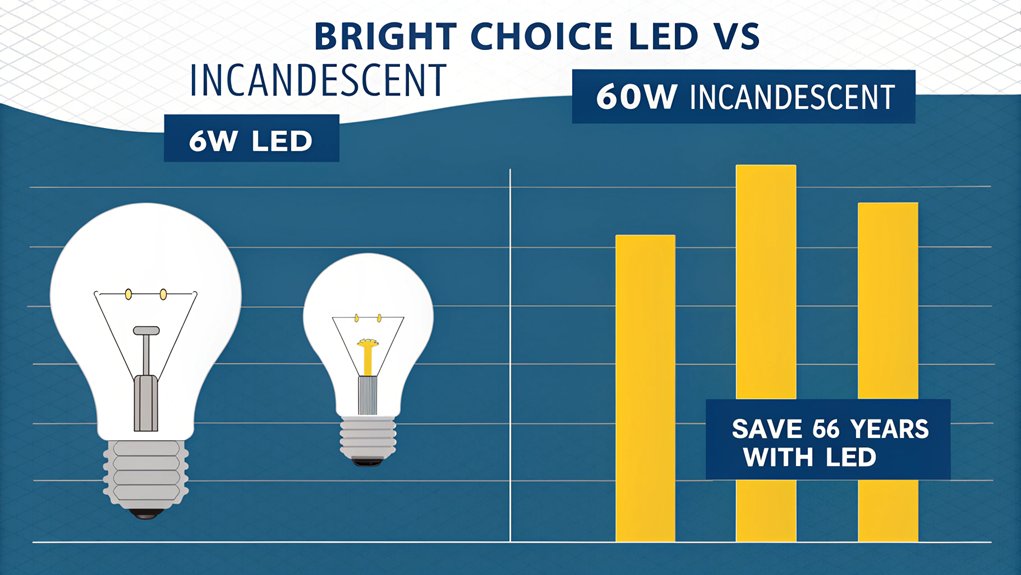
When you compare incandescent and LED bulbs, energy efficiency becomes a key factor. While incandescent bulbs waste much of their energy as heat, LEDs maximize light output, dramatically cutting down on electricity use. Over time, not only do LEDs prove more cost-effective, but they also present a clear advantage in reducing your environmental footprint. Additionally, LEDs are around 5 to 6 times more energy-efficient than incandescent bulbs, making them an even more appealing choice for long-term savings. Furthermore, LEDs have a lifespan that significantly surpasses that of incandescents, lasting up to 50,000 hours compared to the typical 1,000 hours of incandescent bulbs.
Energy Efficiency Comparison
While many people still rely on incandescent bulbs for their lighting needs, the clear advantages of LED technology make a compelling case for a switch.
LEDs consume up to 90% less energy, exceeding current energy standards with an impressive lumens-per-watt ratio of 90-210, compared to just 13 for incandescent bulbs. This translates to significant energy savings and reduced environmental impact, as LEDs generate less heat and lower greenhouse emissions. Additionally, their longer lifespan contributes to fewer replacements and waste, making them a more sustainable choice. Furthermore, LEDs achieve an efficiency rating of 80-90% by converting energy into light, unlike incandescents that only reach 10%.
Beyond efficiency, LEDs offer durability and a lifespan of 25,000 to over 50,000 hours, far outlasting traditional bulbs.
With their vibrant color options and focused lighting capabilities, LEDs embody the latest lighting innovations, enhancing both functionality and sustainability in your home or workspace.
Embrace this transformative technology today.
Cost-Effectiveness Over Time
The significant advantages of LED lighting extend beyond mere energy efficiency; they also offer substantial cost-effectiveness over time compared to traditional incandescent bulbs.
While incandescent bulbs may seem cheaper at $0.50, their energy consumption of 60 watts leads to high running costs, totaling about 219 kWh annually.
In contrast, LEDs, using only 10 watts and lasting up to 25,000 hours, drastically reduce energy use to around 36.5 kWh. This reduction in energy use directly contributes to the average desktop computer uses between 60 and 300 watts. Additionally, LEDs last up to 50,000 hours, which means fewer replacements and lower maintenance costs.
A cost analysis reveals you could save approximately $23 per bulb annually.
Although LEDs have a higher upfront cost of $2.50, the savings projection indicates a quick break-even within a few years, making them a smarter investment for those seeking innovation and lower long-term expenses.
Environmental Impact Assessment
As the world increasingly prioritizes sustainability, understanding the environmental impact of different light bulb types becomes essential.
When comparing incandescent and LED bulbs, consider these points:
- LEDs are 5-6 times more energy-efficient, using only 6-8 watts for the same brightness as a 60-watt incandescent bulb.
- Incandescent bulbs waste 97% of their energy as heat, leading to higher greenhouse gas emissions. This significant waste contributes to 5% of global greenhouse gas emissions tied to lighting.
- A shift to LEDs lowers your carbon footprint considerably, reducing dependency on fossil fuels. In fact, LEDs consume less than 25% of the energy used by incandescent bulbs.
- While LEDs can contribute to light pollution, their energy efficiency often outweighs this concern.
- LEDs last longer, requiring fewer replacements and thereby reducing overall waste.
Daily Usage Patterns: How Long Do You Use Your Desk Lamp?
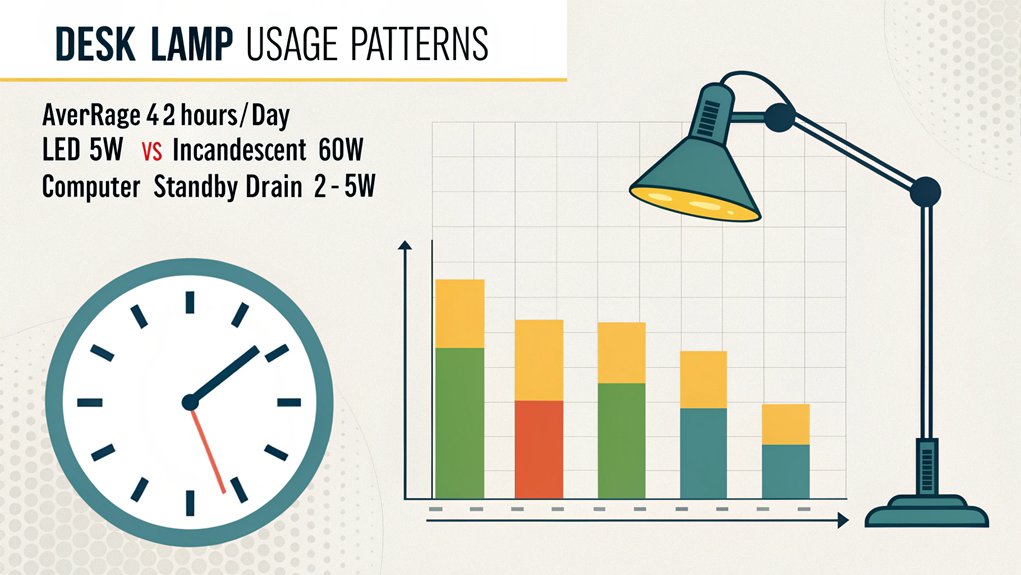
Desk lamps play a pivotal role in your daily activities, especially when it comes to focused tasks like reading or working at a computer. With an average usage frequency of about 1.6 hours daily in the United States, it’s essential to analyze your lighting habits. If you’re using incandescent or CFL bulbs, consider switching to LEDs to maximize efficiency. Higher wattage bulbs consume more electricity than lower wattage bulbs, making the switch to energy-efficient options all the more beneficial. Additionally, consider investing in a lamp like the NÄVLINGE LED work lamp, known for its energy-efficient LED light source, which can further enhance your lighting efficiency. By implementing task-specific lighting strategies and adjustable lamps, you can minimize unnecessary energy consumption while enhancing your workspace. Furthermore, optimizing your lighting setup allows you to decrease energy bills alongside your computer usage. This innovative approach to illumination not only enhances productivity but also reinforces your commitment to sustainable practices in your home or office.
Regional Differences in Lighting Consumption

You might be surprised to learn how cultural preferences and environmental factors shape lighting consumption in your region.
For instance, warmer climates often emphasize bright, efficient lighting to counteract heat, while cooler areas may prioritize softer, traditional lamps.
Understanding these regional differences can help you make more informed choices about your desk lamp and overall energy usage.
Cultural Lighting Preferences
Lighting preferences around the world reflect a fascinating interplay of cultural, geographical, and historical factors that shape how people consume energy. Understanding these cultural influences can help you adopt more efficient lighting solutions while embracing regional aesthetics.
- Historical significance affects how communities perceive light.
- Northern Europeans favor warm, shaded light due to limited daylight.
- Southern Europeans prefer bright, white lighting from abundant sunlight.
- Artisanal designs showcase regional styles and traditions, impacting energy use. Artisan-crafted lighting supports local economies and encourages unique design choices, which may lead to variety in energy consumption patterns.
- Urban lifestyles may lead to sophisticated, energy-efficient lighting choices.
Environmental Factors Influence
As regional differences in environmental factors become more evident, the impact on lighting consumption patterns cannot be overlooked. Understanding how local climates, home sizes, and policies shape your lighting choices is essential for optimizing energy use. The desk lamp market is increasingly shifting toward energy-efficient options, with LED lighting dominating due to its cost-saving characteristics.
| Region | Average Consumption (kWh) | Lighting Type Preference |
|---|---|---|
| West North Central | 1,333 | Incandescent and CFL |
| Midwest | 1,200 | Primarily halogen and LED |
| Urban Areas | 1,100 | Smart and energy-efficient LED |
These regional variations in lighting consumption illustrate the need for adaptive solutions. By embracing innovative technologies, you’re not just saving on costs—you’re contributing to environmental sustainability while staying ahead in a rapidly changing energy landscape.
Calculating Energy Costs for Desk Lamps
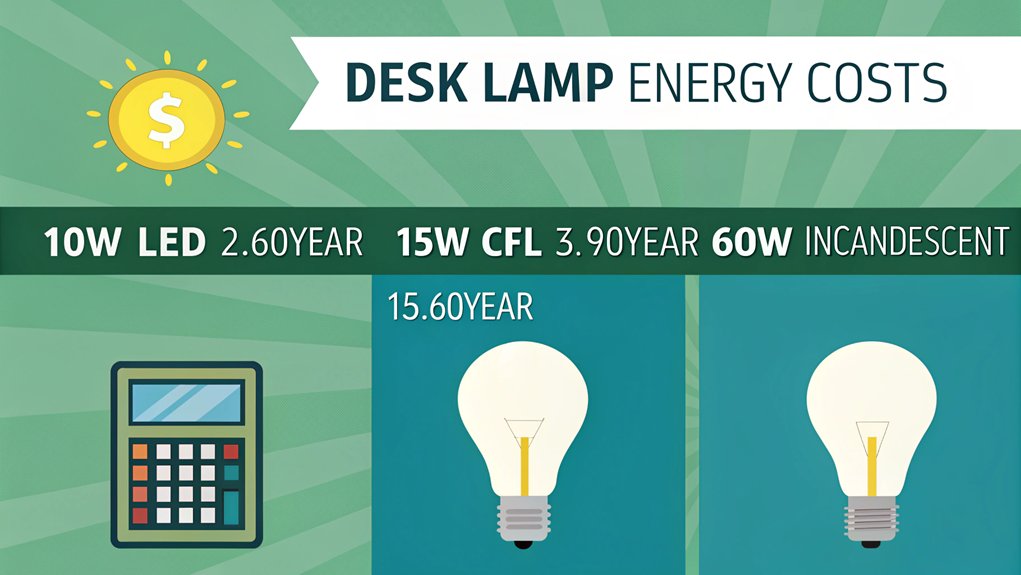
Calculating energy costs for desk lamps is essential for understanding their impact on your monthly electricity bill.
Here’s how you can do it effectively:
- Determine wattage: Desk lamps usually range from 25 to 70 watts.
- Apply the energy usage formula: Multiply wattage by hours used, then divide by 1,000.
- Calculate costs: Multiply kWh by your local rate (around 13.87 cents in the U.S.).
- Know typical usage patterns: Most people use lamps for 4 to 8 hours daily.
- Factor in bulb type: Switching to LEDs can dramatically lower energy costs. Additionally, making this switch can lead to significant monthly savings on your electricity bill, as LED bulbs consume minimal energy compared to traditional bulbs.
The Role of Energy-Efficient Lamps in Reducing Bills
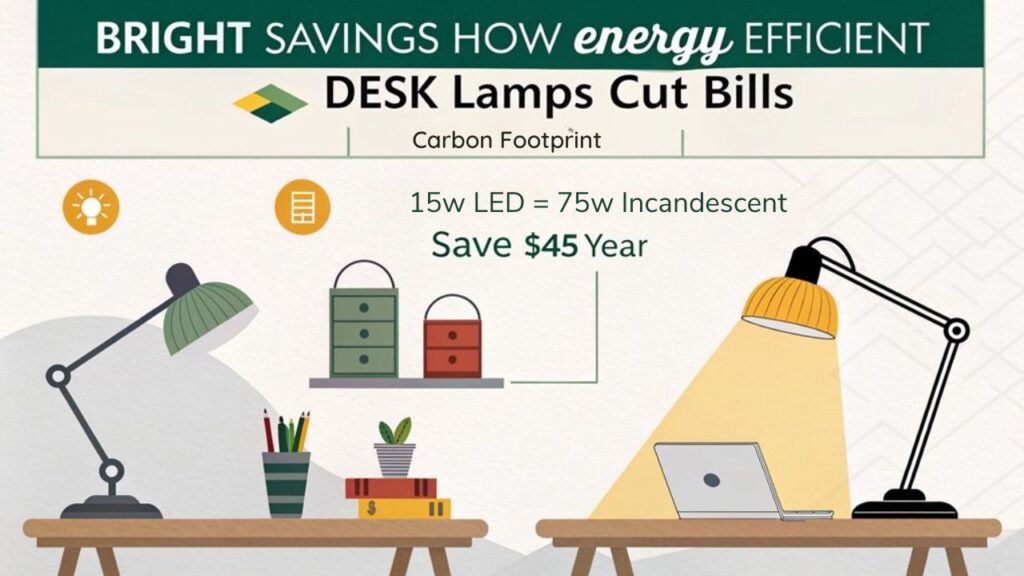
Switching to energy-efficient lamps can lead to significant cost savings on your electric bills while also being a smart long-term investment. Not only do these lamps reduce your overall energy consumption, but they also contribute positively to the environment by decreasing harmful emissions. By making informed choices in lighting, you can shield yourself from rising energy prices and enhance your sustainability efforts. Furthermore, using LED lights can result in energy savings of up to 85%, making them an excellent choice for both your wallet and the planet.
Cost Savings Comparison
Whether you’re looking to cut down on monthly expenses or simply want to make a greener choice, switching to energy-efficient desk lamps can offer substantial savings on your electricity bills.
Here’s why making lighting upgrades pays off:
- LED lamps use up to 90% less energy than incandescent bulbs.
- You could save about $225 annually by choosing energy-efficient options.
- Energy-efficient designs often include smart features like automatic shut-off.
- Adjustable brightness allows you to optimize energy use according to your needs.
- Government incentives can further enhance your cost savings.
- Many energy-efficient desk lamps are also GREENGUARD Certified, promoting healthier indoor environments.
Long-Term Investment Benefits
Upgrading to energy-efficient desk lamps isn’t just about immediate cost savings; it represents a strategic long-term investment that greatly reduces your bills over time.
By switching to LED or CFL lamps, you can enjoy long-term savings of up to 80% on energy consumption compared to incandescent bulbs. With an impressive lifespan of up to 25,000 hours, these lamps minimize maintenance costs, enhancing your overall investment returns. Traditional incandescent bulbs waste energy by converting only 10% into light, making the switch to energy-efficient options even more compelling.
Smart lighting systems further optimize energy usage, ensuring lights are used only when needed. As energy-efficient lighting becomes more appealing to eco-conscious buyers, it can even increase your home’s value.
Ultimately, this innovative approach not only cuts costs now but also bolsters future financial stability.
Environmental Impact Insights
As energy-efficient lamps gain popularity, their role in lowering bills and promoting sustainability becomes increasingly significant. By choosing these sustainable choices, you can actively contribute to energy conservation while reaping financial rewards.
- Decrease energy demand, leading to lower utility costs.
- Minimize carbon emissions, supporting climate change efforts.
- Extend lamp lifespan, reducing waste and resource consumption.
- Integrate smart technologies for optimized energy use.
- Contribute to renewable energy adoption by easing grid pressure.
With smart lighting options enhancing efficiency and productivity, your investment in energy-efficient lamps pays off in more than one way.
Shifting to these innovative solutions not only saves you money but also protects the environment. Make the switch today; your wallet and the planet will thank you!
Smart Lighting Solutions for Home Offices
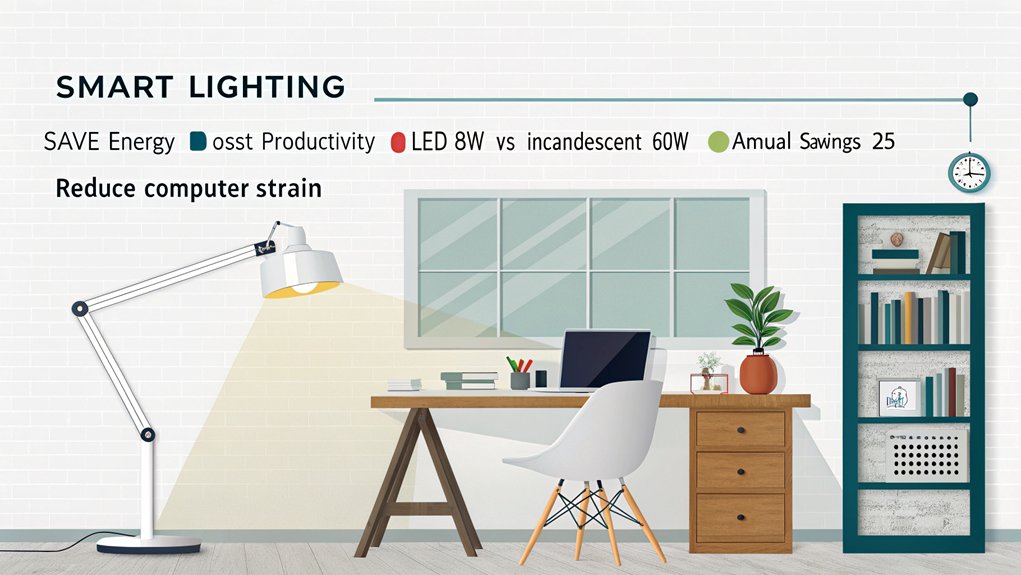
Incorporating smart lighting solutions into your home office can greatly enhance both productivity and comfort. With smart bulb customization, you can adjust light tone and intensity throughout your workday, ensuring you have the right lighting for any task. This flexibility allows you to create the perfect balance between task-oriented and ambient light effects.
| Feature | Benefit |
|---|---|
| Tunable Lighting | Adjusts color and intensity |
| Dimmability | Supports varying work environments |
| IoT Integration | Allows automation and real-time control |
| Energy Efficiency | Reduces overall energy consumption |
Long-Term Savings: The Economic Case for LED Lighting

While many people might overlook the initial investment in LED lighting, the long-term savings make it a smart financial decision.
Overlooking the initial cost of LED lighting could mean missing out on significant long-term savings.
Here’s why you should consider the switch:
- Up to 75% energy savings compared to incandescent bulbs
- Lifespan of 50,000 to 100,000 hours, reducing replacement costs
- Lower maintenance expenses, allowing for operational efficiency improvements
- Rebate and tax deduction programs that offset installation costs
- Immediate economic benefits, enhancing profitability and brand reputation
With these LED savings, you’ll not only enjoy reduced electricity bills but also benefit from various economic incentives.
As LED technology advances, it becomes increasingly clear that investing in LED lighting is a forward-thinking choice that pays off in the long run.
Environmental Benefits of Switching to Efficient Lighting
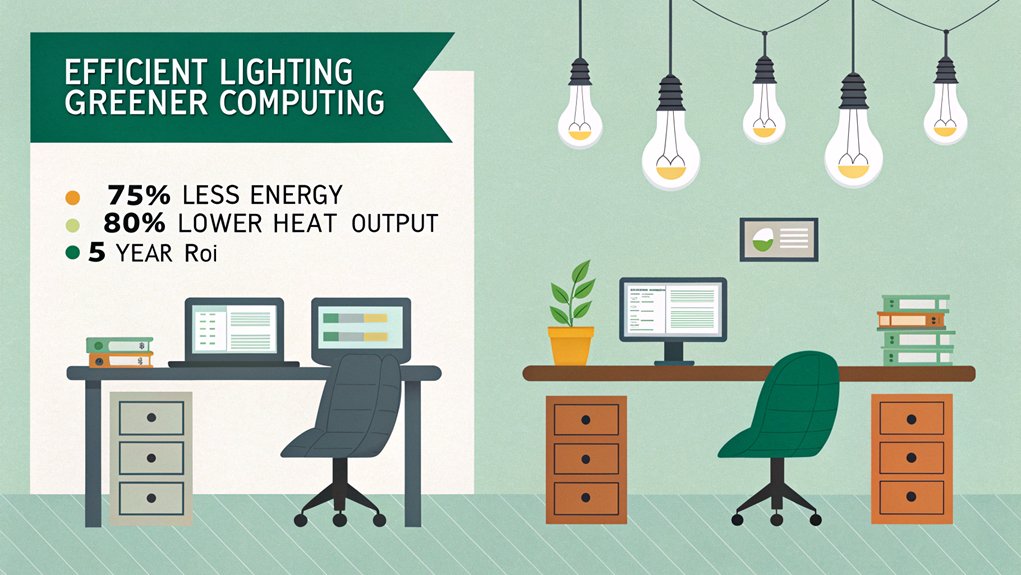
Switching to efficient lighting, especially LED technology, not only enhances your home or workspace’s aesthetic but also greatly benefits the environment. By adopting LEDs, you actively participate in sustainability practices while reducing your carbon footprint. These lights consume up to 80-85% less energy, leading to less reliance on fossil fuels and lower greenhouse gas emissions. Plus, they don’t contain hazardous materials like mercury, making disposal safer.
| Benefits | Energy-Efficient Lighting | Traditional Lighting |
|---|---|---|
| Energy Consumption | 80-85% less | High |
| Lifespan | Up to 25,000 hours | Short |
| Environmental Impact | Lower pollution | Higher pollution |
Embrace eco-friendly materials and join the movement towards a sustainable future by choosing LED lighting.
Integrating Desk Lighting With Overall Home Office Efficiency

As you look to enhance your home office’s efficiency, integrating effective desk lighting is essential for maximizing productivity and comfort.
Proper desk lighting integration not only illuminates your workspace but also optimizes your overall work experience.
Consider these key benefits:
- LED lamps reduce eye strain with focused illumination.
- Adjustable features allow personalized lighting for various tasks.
- Energy-efficient design cuts electricity costs while maintaining performance.
- Long-lasting bulbs minimize replacement frequency.
- Aesthetic variety enhances your workspace’s appeal.
Frequently Asked Questions
Can Desk Lamps Affect Computer Performance or Functionality?
Desk lamps generally don’t cause performance issues for computers. However, lamp energy inefficiencies can create potential interference. Opt for energy-efficient models like LEDs to guarantee ideal lighting without compromising your device’s functionality and performance.
How Does Lamp Placement Impact Desk Lamp Energy Consumption?
Is your lamp positioned for maximum efficiency? Proper lamp placement can enhance lighting angle and considerably boost lamp efficiency, reducing energy consumption while providing ideal illumination for your tasks, making your workspace more productive and sustainable.
Is There an Optimal Brightness Level for Desk Lamps Related to Computer Use?
For ideal computer use, adjust brightness levels to guarantee lighting comfort. Aim for 450 to 700 lumens, utilizing adjustable features for personalized settings that enhance focus and productivity during your tasks. Prioritize innovation in your lighting choices.
Can I Use a Desk Lamp With a Computer’s USB Port?
You can use a desk lamp with your computer’s USB port, but guarantee USB lamp compatibility and respect power output limitations. Opt for energy-efficient designs that enhance functionality while maintaining safety and peak performance.
Do Desk Lamps Emit Any Harmful Radiation Affecting My Computer Usage?
Desk lamps typically don’t emit harmful radiation affecting your computer usage. However, watch for potential electromagnetic interference from smart lamps. Reducing radiation exposure involves maintaining distance and opting for safer lighting options like warm LEDs.
Conclusion
To sum up, optimizing your desk lamp’s power consumption can greatly impact your overall energy usage and costs. Did you know that switching to an LED desk lamp can save you up to 80% on lighting energy expenses? By making this simple change, you’re not just lowering your bills; you’re also contributing to a greener planet. Embracing energy-efficient lighting is a smart investment that enhances your workspace while paving the way for sustainable living. Make the switch today!

I am a retired software engineer with experience in a multitude of areas including managing AWS and VMWare development environments. I bought a relative a mini-PC a year ago and have become passionate about the technology and its potential to change how we deploy software.

